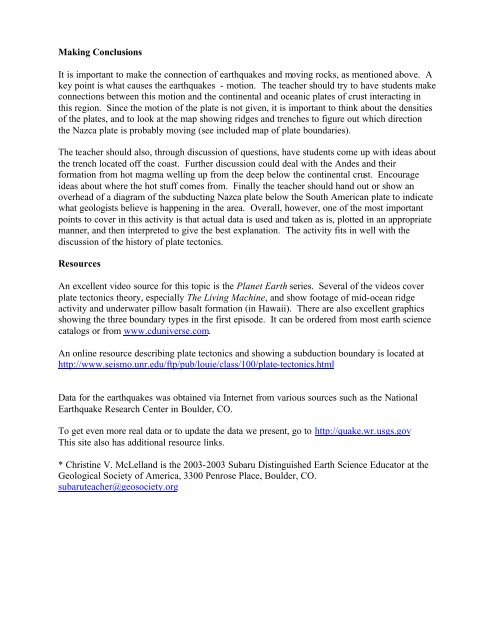Real Evidence of a Subducting Plate - Geological Society of America
Real Evidence of a Subducting Plate - Geological Society of America
Real Evidence of a Subducting Plate - Geological Society of America
You also want an ePaper? Increase the reach of your titles
YUMPU automatically turns print PDFs into web optimized ePapers that Google loves.
Making Conclusions<br />
It is important to make the connection <strong>of</strong> earthquakes and moving rocks, as mentioned above. A<br />
key point is what causes the earthquakes - motion. The teacher should try to have students make<br />
connections between this motion and the continental and oceanic plates <strong>of</strong> crust interacting in<br />
this region. Since the motion <strong>of</strong> the plate is not given, it is important to think about the densities<br />
<strong>of</strong> the plates, and to look at the map showing ridges and trenches to figure out which direction<br />
the Nazca plate is probably moving (see included map <strong>of</strong> plate boundaries).<br />
The teacher should also, through discussion <strong>of</strong> questions, have students come up with ideas about<br />
the trench located <strong>of</strong>f the coast. Further discussion could deal with the Andes and their<br />
formation from hot magma welling up from the deep below the continental crust. Encourage<br />
ideas about where the hot stuff comes from. Finally the teacher should hand out or show an<br />
overhead <strong>of</strong> a diagram <strong>of</strong> the subducting Nazca plate below the South <strong>America</strong>n plate to indicate<br />
what geologists believe is happening in the area. Overall, however, one <strong>of</strong> the most important<br />
points to cover in this activity is that actual data is used and taken as is, plotted in an appropriate<br />
manner, and then interpreted to give the best explanation. The activity fits in well with the<br />
discussion <strong>of</strong> the history <strong>of</strong> plate tectonics.<br />
Resources<br />
An excellent video source for this topic is the Planet Earth series. Several <strong>of</strong> the videos cover<br />
plate tectonics theory, especially The Living Machine, and show footage <strong>of</strong> mid-ocean ridge<br />
activity and underwater pillow basalt formation (in Hawaii). There are also excellent graphics<br />
showing the three boundary types in the first episode. It can be ordered from most earth science<br />
catalogs or from www.cduniverse.com.<br />
An online resource describing plate tectonics and showing a subduction boundary is located at<br />
http://www.seismo.unr.edu/ftp/pub/louie/class/100/plate-tectonics.html<br />
Data for the earthquakes was obtained via Internet from various sources such as the National<br />
Earthquake Research Center in Boulder, CO.<br />
To get even more real data or to update the data we present, go to http://quake.wr.usgs.gov<br />
This site also has additional resource links.<br />
* Christine V. McLelland is the 2003-2003 Subaru Distinguished Earth Science Educator at the<br />
<strong>Geological</strong> <strong>Society</strong> <strong>of</strong> <strong>America</strong>, 3300 Penrose Place, Boulder, CO.<br />
subaruteacher@geosociety.org
















